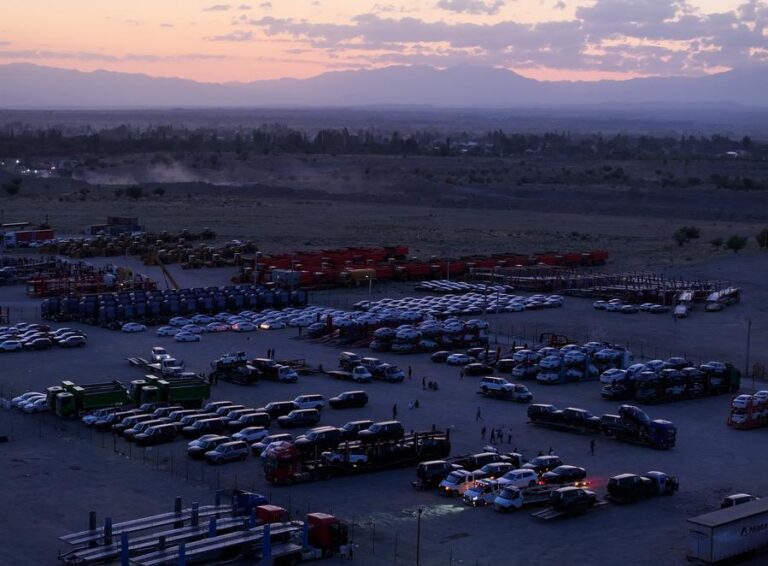* In Horgos, a more flexible and cost-effective “self-driving export” has significantly facilitated the development of related businesses and continuously improved customs clearance efficiency since the agreement on mutual visa exemption between China and Kazakhstan went into force.
HORGOS, China, Sept. 15 (Xinhua) — A few kilometers away from the road port of Horgos in northwest China’s Xinjiang Uygur Autonomous Region, alongside the Lianyungang-Horgos Expressway, rows of vehicles can be seen neatly parked, awaiting export. Many of them will be driven out of the country by individual car drivers through a process known as “self-driving export.”
Horgos, which means “a place where camels pass” in Mongolian and “a place for accumulating wealth” in Kazakh, was once a bustling passage used by traders traveling along the ancient Silk Road. While it lost its shine after caravans faded into history, the Belt and Road Initiative, proposed by China in 2013, has revitalized the old port.
SELF-DRIVING EXPORT
In Horgos, a more flexible and cost-effective “self-driving export” has significantly facilitated the development of related businesses and continuously improved customs clearance efficiency since the agreement on mutual visa exemption between China and Kazakhstan went into force.
Compared with truck transportation for exports, delivering vehicles via individual car drivers is more cost-efficient and is increasingly popular among foreign car importers. Thousands of people are engaged in this new way of car transportation in Horgos, turning ordinary drivers into important trade links and earning them the name “ferrymen.”
Ferrymen drive new vehicles to the customs supervision area at the Kazakh border, hand over the vehicles to foreign importers, and then take the return buses. Thanks to the visa-free policy between China and Kazakhstan, the industry has created employment opportunities for over 7,000 people in the surrounding areas. Currently, Horgos stands as the largest land port for automobile exports in China.
“I am one of the first ferrymen in Horgos,” said Wen Jiang, who has been working as a part-time ferryman since 2023, adding that he makes more than a dozen round trips each month and earns seven to eight thousand yuan (around 1,000 U.S. dollars).
“ONE-STOP” CUSTOMS CLEARANCE
In the past, freight drivers had to carry a thick pile of paper documents and queue up at each service counter. Now, when vehicles reach the port, the drivers don’t need to get out of their vehicles to cross the border thanks to the “one-stop” customs clearance system.
According to local officials, in response to the growing volume of automobile exports and the need for timely cross-border transport, Horgos has introduced “a fast-track customs clearance model” for self-driving vehicle exports.
Through the international trade window, enterprises can submit information in advance and generate a QR code. At any time, once the vehicles arrive at the centralized customs inspection yard, a quick scan at the smart checkpoint allows them to pass immediately.
“Through scanning, the vehicle’s information is automatically checked, which saves a great deal of waiting time,” said Wang Rui, who became a ferryman last year. As of Sept. 8, ferrymen had transported more than 100,000 vehicles through the road port this year, according to the entry-exit border inspection station of Horgos.
The remarkable improvement in the customs clearance process at the road port of Horgos also renders the working hours relatively flexible, Wang said while explaining why he chose to be a ferryman.
“I used to work as a truck driver, but now I transport brand-new cars. The more cars you deliver, the more income you can get,” he said.
POPULAR IN CENTRAL ASIA
Many of the vehicles transported by the ferrymen are new energy vehicles (NEVs). Wen told Xinhua that he had noticed an increasing number of Chinese NEV brands on Kazakhstan’s roads, such as Li Auto and Changan Auto.
Nurzhan, a resident of Almaty, owns a Li Auto L9. “At least five of my friends have bought this car. It performs just as well as those of other brands that are two or three times more costly.”
The demand from Central Asian consumers for Chinese automobiles, particularly NEVs, has been on the rise. Chinese automakers are not only enabling more people in other countries to enjoy cost-effective and comfortable new energy vehicles through exports, but are also driving local industrial growth and creating jobs through investment and cooperation.
At present, a growing number of Chinese car companies are investing in Central Asia, helping to upgrade China-Central Asia economic and trade cooperation and advance the integrated development of industrial and supply chains.■

